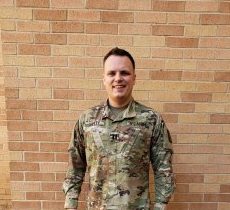Army officers expecting to move next summer are experiencing an entirely new way of selecting and receiving their next assignments. They will now partake in the Army Talent Alignment Process (ATAP) for their next and future assignments.
ATAP is a decentralized, regulated, market-style hiring system that aligns officers with jobs based on preferences. Officers use AIM 2.0 to access the ATAP until it becomes available in the Integrated Personnel and Pay System — Army (IPPS-A).
Capt. Travis Salley recently received an assignment through the ATAP. He is currently enrolled in the Signal Corps Captain’s Career Course at Fort Gordon, Ga.
Q: Tell us about yourself. What is your rank and branch? What assignment were you in when you started to get ready for your next assignment?
I enlisted in the Nevada National Guard as a combat engineer in 2010. I commissioned in 2013 from the University of Nevada-Reno ROTC program into the U.S. Army Reserve. I transitioned to active duty through the “Call-to-Active Duty Program” in 2017. My previous assignment was as the Battalion S-6 for the 10th Brigade Engineer Battalion, 1st Armored Brigade Combat Team, 3rd Infantry Division.
Q: How did you first learn about Assignment Interactive Module (AIM) 2 and the marketplace?
I found out about AIM 2 through my branch manager, CPT Robert Villareal.
Q: Did anyone explain how this process worked?
My branch manager explained that I needed to preference the assignments I was interested in so I could achieve a “match”. I was not able to contact the Point of Contact listed on my top assignment. After conferring with my branch manager, he advised to contact the unit directly.
Q: How many assignments were available to you in the marketplace?
There were about eighty assignments in my marketplace, all of which were either Battalion S-6 positions or signal company commands, which are key developmental positions for my branch.
Q: Tell us about building your resume.
I included my civilian career experience in my resume. I also mentioned my short tour to Puerto Rico in 2017 following Hurricane Maria. Neither of these appear on my ORB.
Q: Everyone has unique talents that aren’t always reflected on our official records. What makes you unique?
I was a stock broker and financial advisor for Edward Jones and Wells Fargo Advisors. I closed over $50 million in new business and I trained new brokers. Additionally, I am a classical pianist with a masters in music. I taught music history at the University of Massachusetts-Amherst as a graduate student instructor.
Q: Everyone has different preferences when it comes to assignments. What specifically were you looking for?
I was interested in company command, which is difficult to get in my branch. AIM 2 allowed me to search for available commands and schedule an interview.
Q: How many assignments did you preference in the marketplace?
My branch manager advised me to preference all available assignments in the marketplace, so I preferenced all eighty.
Q: AIM 2 allows a person to learn more about the organization. Did you find that feature useful?
This was extremely helpful. Units who filled them out gave me a better understanding if that was an organization I wanted to join. For example, I saw some units said they were deploying. This is important information for those who wish to deploy, for the unit and the soldier.
Q: What can units do to make this process better?
Commanders must play an active role in this process and seek out the talent they need. I was more likely to preference an assignment if the unit took the time to provide information about their organization. Additionally, units must ensure they vet the POC for each assignment. A commander or a staff primary position likely should have different POCs, even if they belong to the same unit.
Q: How did the interview process work?
I reached out the battalion commander. I forwarded my OERS, ORB, resume, and my desire to serve in the organization and she offered me the job! The job and location was my top choice.
Q: Are you happy with the results of ATAP?
Yes, I felt like I could control my destiny. The system allows soldiers to have meaningful influence on their career and I believe the matching system is beneficial for all parties.
Q: Do you know when you report?
February 25.
For more information on the Army Talent Alignment Process, visit the Army Talent Management website at https://talent.army.mil.
